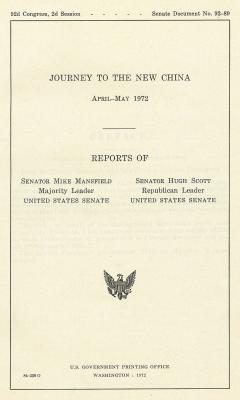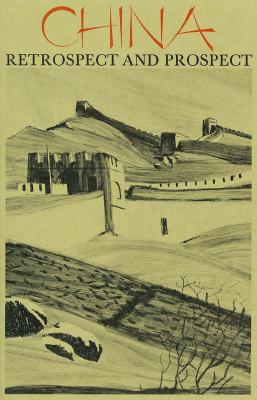China Revisited:
Mike Mansfield and the U.S. Opening to China in 1972
By Nolan Franti, August 2012

President Richard Nixon ended more than twenty years of economic and political isolation between Communist China and the United States in 1972 when he became the first U.S. President to visit the People’s Republic.[1] Nixon’s historic visit, widely considered one of the most successful policy initiatives of his presidency, became the first step in the normalization of U.S.-China relations.[2] President Nixon’s overture to China would not have been possible, however, without the efforts of Montana’s Senator Mike Mansfield, Majority Leader in the Senate and a longstanding policy expert on East Asian affairs. Not only did Mansfield receive an offer to visit the People’s Republic before Nixon—an offer which paved the way for Nixon’s own visit—but Mansfield’s view of the necessity of a Chinese overture largely accorded with Nixon’s own and helped launch a new era of peaceful Chinese-American relations.
Mike Mansfield’s interest in East Asian policy grew out of his experiences in Asia in the Marines and as a U.S. Congressman. In 1922, Mansfield visited the Chinese cities of Tientsin and Shanghai while stationed in the Philippines as a private in the U.S. Marine Corps.[3] Although Mansfield’s visit to China came during the Warlord Period, a low point in modern Chinese history, it nonetheless helped to spark a lifelong interest in China and East Asian affairs. He taught courses in Far Eastern history as a member of the University of Montana faculty and, in 1944, during his time in U.S. House of Representatives, Mansfield convinced President Roosevelt to send him to China as a special emissary.[4]
Through these experiences, Mansfield developed an interest in the United States policy in Asia that came to include a deep concern about growing U.S. involvement in Indochina during the Vietnam War. As Senate Majority Leader, Mansfield remained an opponent of U.S. military involvement in Southeast Asia, arguing that the U.S. had no vital interests in Vietnam and could not justify sacrificing large numbers of lives and amounts money for what he perceived was a futile objective.[5]
Increasingly, Mansfield believed that the route to ending the war in Vietnam would come through a fundamental reassessment of the United States’ relationship with China.[6] In a 1968 speech entitled “China: Retrospect and Prospect” that Mansfield gave at the University of Montana, he expressed his view that “there will be no durable peace in Korea, Viet Nam, or anywhere else in Asia unless there is a candid confrontation with the problems of the Sino-U.S. relationship.”[7] Mansfield argued that the “almost cyclical” nature of the relationship, in which alternating periods of Western infatuation and fear of China dominated U.S. policy, had to be overcome to end the mutual distrust and suspicion between the two sides.[8]

Mansfield had appealed to President Lyndon Johnson in 1967 to pursue a trip to China—if Chinese officials would allow him—with the aim of starting talks to end the war in Vietnam, a conflict in which both the United States and China had strategic interests. Though he agreed that a visit to China would be “most useful,” Johnson privately cautioned Mansfield, “I frankly doubt the Chinese would admit you.” The matter was settled when then-Secretary of State Dean Rusk rejected the idea of a Mansfield visit, declaring that it would produce “great confusion among our friends in free Asia, including the fear that we were about to sell them out.”[9] The issue of re-opening ties with China would lie dormant until the next administration.
The election of Richard Nixon to the Presidency in 1968 brought a staunchly anticommunist Republican to the White House. Despite his anticommunist credentials, however, Nixon had come to hold a firm belief that re-opening ties with China was in the national interest. In an October 1967 article in the policy journal Foreign Affairs, Nixon had argued, “Taking the long view, we simply cannot afford to leave China forever outside the family of nations…There is no place on this small planet for a billion of its potentially most able people to live in angry isolation.” Though he kept his intentions secret, President Nixon made an opening to China a central part of his foreign policy agenda during his first term.[10]
Mansfield made his second bid to visit China in July of 1969, when he sent a letter to Chinese Premier Zhou En-lai by way of Cambodian leader Prince Norodom Sihanouk. The letter contained Mansfield’s request to visit the PRC to discuss issues of importance between the two nations, including the resolution of the conflict in Vietnam.[11] After deliberation, Chinese leaders chose to deny Mansfield’s request—at least for the time being. Zhou En-lai’s response, dated August of 1969, rejected the idea of a visit, citing “a policy of hostility to the Chinese people and [the U.S.] occupying by force the province of Taiwan” as stumbling blocks in Chinese-U.S. relations.[12] For the second time, it seemed Mansfield’s chance to revisit China had disappeared.
Yet two years later, by the spring of 1971, China had made a fundamental strategic reassessment that the Soviet threat surpassed the threat the U.S. posed to China.[13] Mansfield received a letter from Prince Sihanouk stating that Zhou En-lai had finally agreed to invite the Senator to Beijing at a date of his convenience. With the consent President Nixon, Mansfield sent a reply to Zhou accepting the offer–only to find have his letter returned to the sender: The U.S. Postal Service would not accept registered mail to the People’s Republic. The letter was thus sent via diplomatic channels instead.[14]
While waiting for a reply, Mansfield wrote a letter to Prince Sihanouk, dated June 1, 1971, in which he again expressed his personal desire “that [a visit] might lead in this country to a better perception of the issues of Taiwan and Indochina as they relate to outstanding questions between the China and the United States.” Mansfield also hoped that his friendship with Prince Sihanouk, now exiled and living in Beijing, could be used to diplomatic effect in negotiating an end to the Vietnam conflict. He thus expressed a desire “to have an opportunity for a direct discussion with you in Peking on ending the war… and on what will be involved with the rehabilitation of all the Indochinese countries after this tragedy is ended.”[15]
Although President Nixon supported the idea of a Mansfield trip to China, he backtracked when it appeared that his own invitation to visit the People’s Republic would soon be forthcoming.[16] In the end, National Security Advisor Henry Kissinger was the first to visit China, making a secret trip in July 1971 to arrange the Nixon visit. Nixon publicly announced his acceptance of the invitation on July 15, 1971, and made his historic visit to China in February of the next year.[17] Diplomatic talks resulted in the Shanghai Communiqué, a document that affirmed a new era of U.S.-Chinese cooperation while dancing around the delicate issues of Taiwan and Indochina.[18]
Mansfield soon followed, travelling to the People’s Republic of China in April and May 1972 with his Republican counterpart in the Senate, Minority Leader Hugh Scott.[19] During their 16-day trip they visited Beijing, where Mansfield conversed with Premier Zhou En-lai (with whom he was to establish a close relationship), Shanghai, Guangzhou (formerly Canton), and communes in the Chinese countryside.[20] Mansfield’s visit to China was the culmination of his dream to revisit China after more than 25 years of diplomatic isolation between the two countries.
Upon returning to the United States, Mansfield completed an official report documenting his and Minority Leader Scott’s trip and outlining his observations and conclusions. The report, entitled “Journey to the New China,” stressed the positive aspects of China’s economic and social growth in the 25-year period since the creation of the Communist Government.[21] Overlooking the chaotic excesses of the ongoing Cultural Revolution, Mansfield concluded that China “has become a viable modern society with an approach to social participation and responsibility which is rooted in the past, meets the needs of the present, and offers a soundly based hope for the future.”[22] Regarding the issue of U.S. involvement in Indochina, Mansfield commented, “…it is apparent that Vietnam is fundamental to a further relaxation of tensions in the Western Pacific” and cited the official Chinese response to the issue: “Unless this issue can be settled, there can be no progress on other issues.”[23]
Nixon’s policy of “détente in Asia,” had mixed, though mostly positive, results. Though it did decrease regional tensions in East Asia, rapprochement between the United States and China did not lead to a speedy end to the conflict in Vietnam, as Mansfield had hoped. The slow de-escalation of the war in Vietnam would continue until the war’s final end in 1975, under the Ford administration.[24] Nixon’s efforts to open and then strengthen ties with China did result, however, in increased trade and the slow but steady normalization of diplomatic relations, which culminated in full diplomatic recognition of the People’s Republic of China under President Carter in 1979.[25]
Nixon and Kissinger have received fulsome and deserved praise for formulating the China policy that bore fruit in the years following Nixon’s first visit to China. Credit should also be given, however, to Senator Mansfield, for the ground-breaking efforts he made to produce the first invitation of a U.S. Government official to visit Communist China. Mansfield’s far-sighted vision of a world in which the U.S. and China could peaceably coexist and even mutually benefit has certainly been vindicated by China’s growth as a U.S. trading partner and the tremendous effects of China’s continuing economic reform and opening to the West.
Questions about the essay can be sent to library.archives@umontana.edu.

